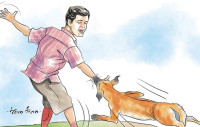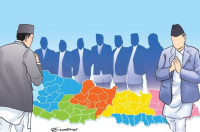Columns
Still untouchable
Navaraj BK and his friends died because he loved an upper-caste girl. He won’t be the last..png&w=900&height=601)
Amish Raj Mulmi
There are some events that shock one to the core and drag us by the collar out of our complacent privileged lives. In the past week, one such event occurred in Rukum, where Navaraj BK, a 21-year-old boy from Jajarkot, was mercilessly beaten up and then thrown into the Bheri river. Four others of a party of 19 were also killed, and one is still missing after jumping into the river to escape a mob. All this, because the Dalit boy dared to love an upper-caste 17-year-old girl from Soti village in Rukum.
The boy was an athlete; he was popular; his pictures seemed to evoke a charm that comes naturally to one with confidence. But the upper castes didn't care. All that mattered for them was that he was a BK, a Bishwokarma, a Dalit. How dare a maker of tools hope to love a Thakuri? How dare he dream of marrying her? And how dare he try to elope with her the second time, when he had already tried a previous time and been detained? The damage to the fragile upper-caste ego was done; the Dalit had to be taught a lesson.
'Why has this Dom (a caste slur) returned? Wasn’t he satisfied by the previous time’s beating? (translation mine)' the girl’s mother, Prakashi Malla, allegedly said when the group arrived in Soti village. A mob of 50-60 then gathered, and began to chase them, beat up the ones they caught, and singled out Navaraj. Others in the party jumped into the river to escape the beating.
Such savagery is systemic; the wounds of this incident hadn’t even scabbed when another, equally savage, incident of upper-caste violence occurred. In Devdaha, Rupandehi, a 13-year-old Dalit girl was raped by 25-year-old Birendra Bhara, an upper-caste man. The solution: get the 13-year-old married to her rapist! But the rapist’s family refused to accept this ‘marriage’. The girl was then found hanging from a tree. The police deemed it a suicide at first and ignored it, despite the incident’s background (this is an oft-repeated model of investigation, as we shall see). It took the police four days to even register a complaint.
How does one reconcile oneself to such mockery of the law? Where does one even start? Despite the stringent criminalisation of untouchability in 2011, 18 Dalits have lost their lives to caste violence since then. And, five years ago, Nepal’s new constitution added extra protections for Dalits. Yet, rooms aren’t rented to them; Dalit women in inter-caste marriages are forced to abort; even elected Dalit representatives are given separate plates to eat from.
The outcry is natural. The government has formed a committee, as usual, to investigate. But deep down, we know this will happen again, and again. After all, it has happened before. In 2016, 18-year-old Ajit Mijar married his upper-caste girlfriend Kalpana Parajuli. Five days later, his body was found hanging. When the family arrived, they found the police had already buried Mijar without any investigation, declaring it as—what else—a suicide. Again, a government committee was formed.
In 2018, 20-year-old Maya Bishwokarma of Kailali was gang-raped by four of her co-workers, led by Ganesh Baduwal. 'As Baduwal confessed to the police, they had raped her because she had refused to have sex with him, which he demanded as a “married man and that too from a high caste family.”’ Not satisfied with the rape, the four then murdered her. The bodies of Dalit women aren’t considered their own; in the eyes of the upper caste, they have no agency. 'My spit from down there is acceptable, spit from my mouth is acceptable, but why isn’t food and water from my hands acceptable?' activist Sarita Pariyar quotes a woman from the far-west.
In India, despite the Ambedkar political awakening, caste violence continues. In Nepal, without any Ambedkars to force the upper castes’ hand, we've built inequality into our very edifice. In 1806, a Damai had flesh cut out from his back, and salt and lemon rubbed on his wounds on charges of cow slaughter, then made to eat his own flesh before being killed. Jung Bahadur’s Muluki Ain institutionalised caste discrimination. All our ‘revolutions’, including the Maoist one—that so-called herald of progressive thought—were mostly led by upper-caste brahmin men. And our rulers today, all fed on a diet of communism that preaches no religion and no inequality, are conveniently pursuing a constitution with gender bias and sanatana dharma (read Hinduism) at its heart.
It's difficult for Nepalis to look beyond caste because our society has perfected the art of exclusion. In an ethnically diverse society like ours, this has compounded the inequities. The Muluki Ain’s neat slotting of the caste matrix has seeped into our very being, and we simply cannot imagine a society where, say, a Dalit woman is our prime minister, or a Tharu our president. Racial stereotypes perpetuate this state. Too many times while travelling in the mountains have I heard pahadi policemen saying locals would make for terrible officials because they are lazy. Our TV shows find it funny to paint a black face and imitate a Madhesi; no wonder it is said comedy reflects society.
When inequality is normalised, the law makes little sense, for it operates differently for different people. A Tharu girl is found hanging, her clothes dishevelled, her shoe elsewhere, and it is deemed a suicide. '[B]etween January 2017 and February 2019, there were 30 cases where the cause of death was initially reported as a suicide, but in which other parties (usually the family of the deceased) believed it to be murder...In 25 of the 30 disputed cases, the victim was female, usually young, and in 23 of the cases, the body was found hanging.'
To those who suggest such incidents must not be ‘politicised’—that they possess the privilege to suggest so is itself an indication of where they are placed on the social ladder. Caste is political, as is the impunity of a few and the helplessness of others. There will be other Navarajs, Ajits and Pramilas as long as caste remains the foundation of our society.
***
What do you think?
Dear reader, we’d like to hear from you. We regularly publish letters to the editor on contemporary issues or direct responses to something the Post has recently published. Please send your letters to [email protected] with "Letter to the Editor" in the subject line. Please include your name, location, and a contact address so one of our editors can reach out to you.




 14.12°C Kathmandu
14.12°C Kathmandu















